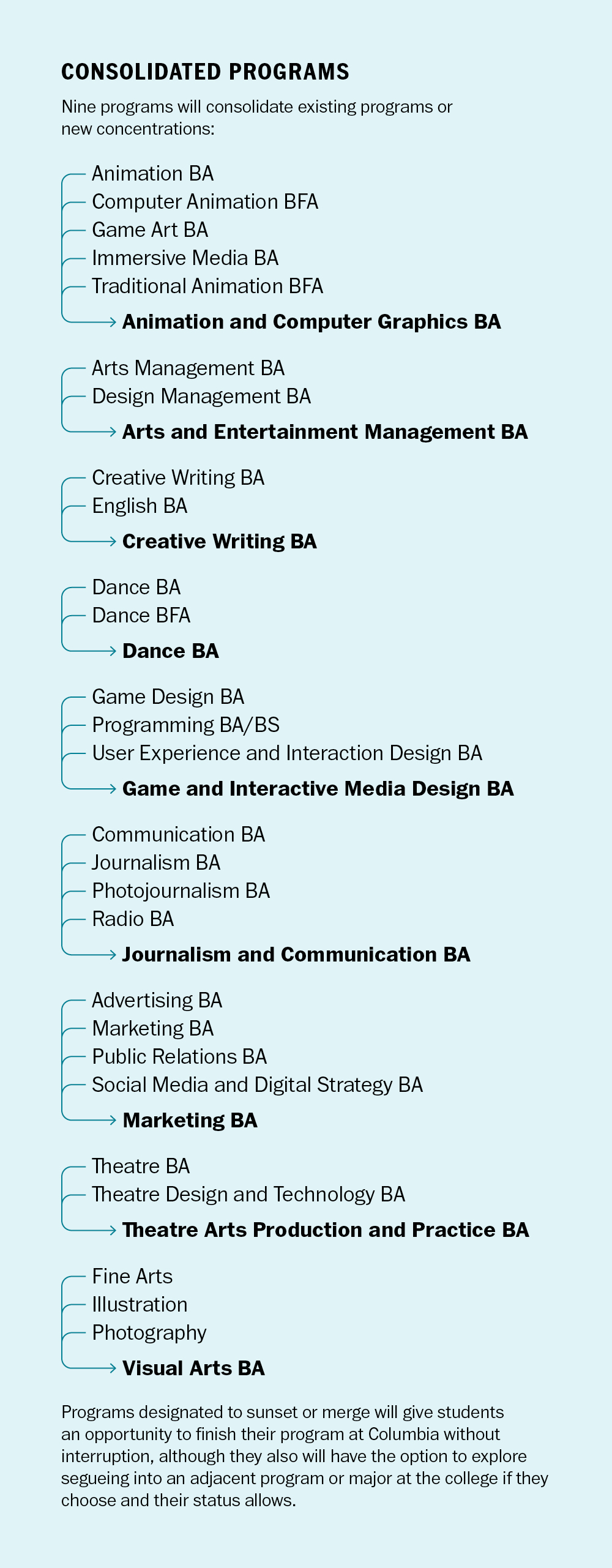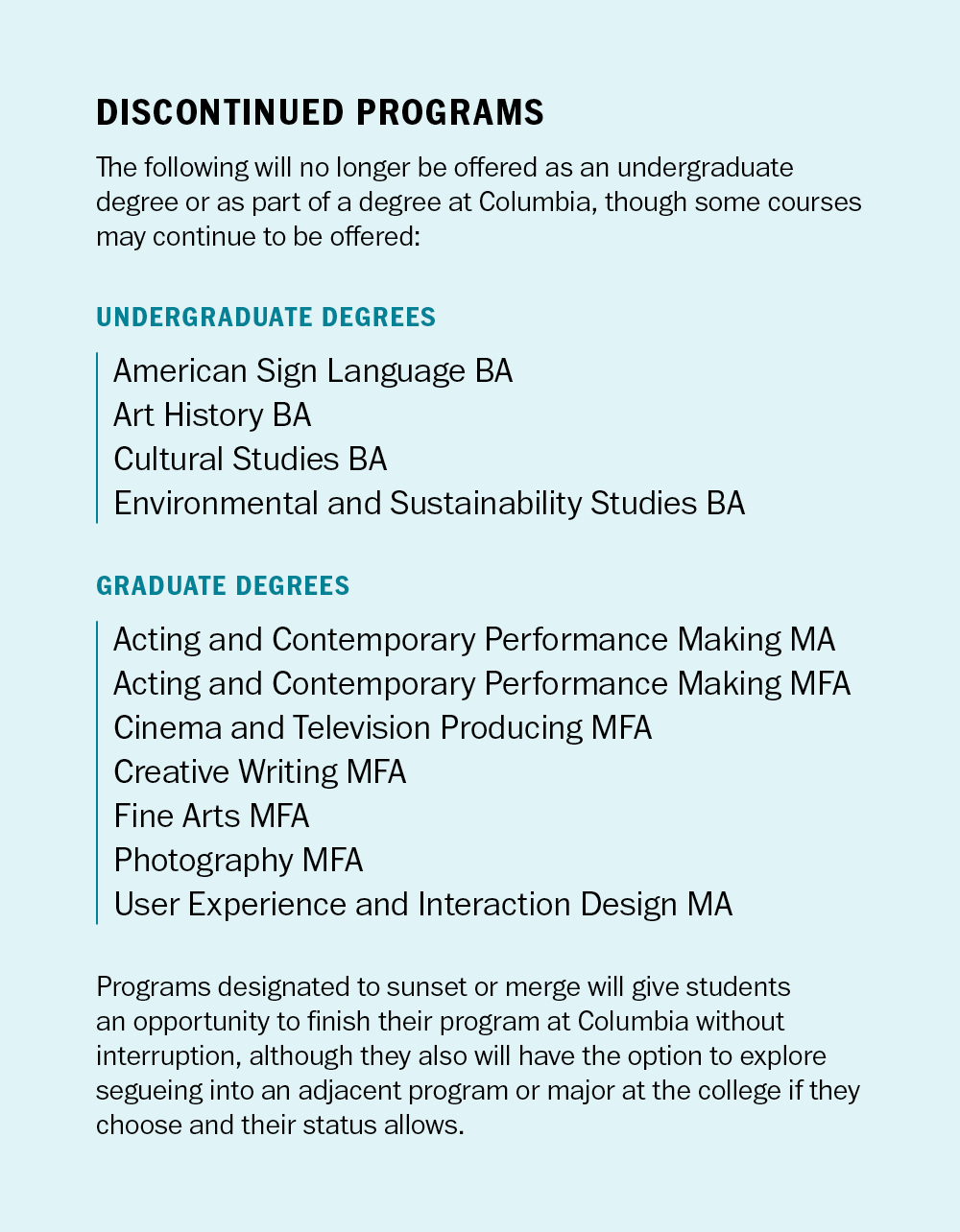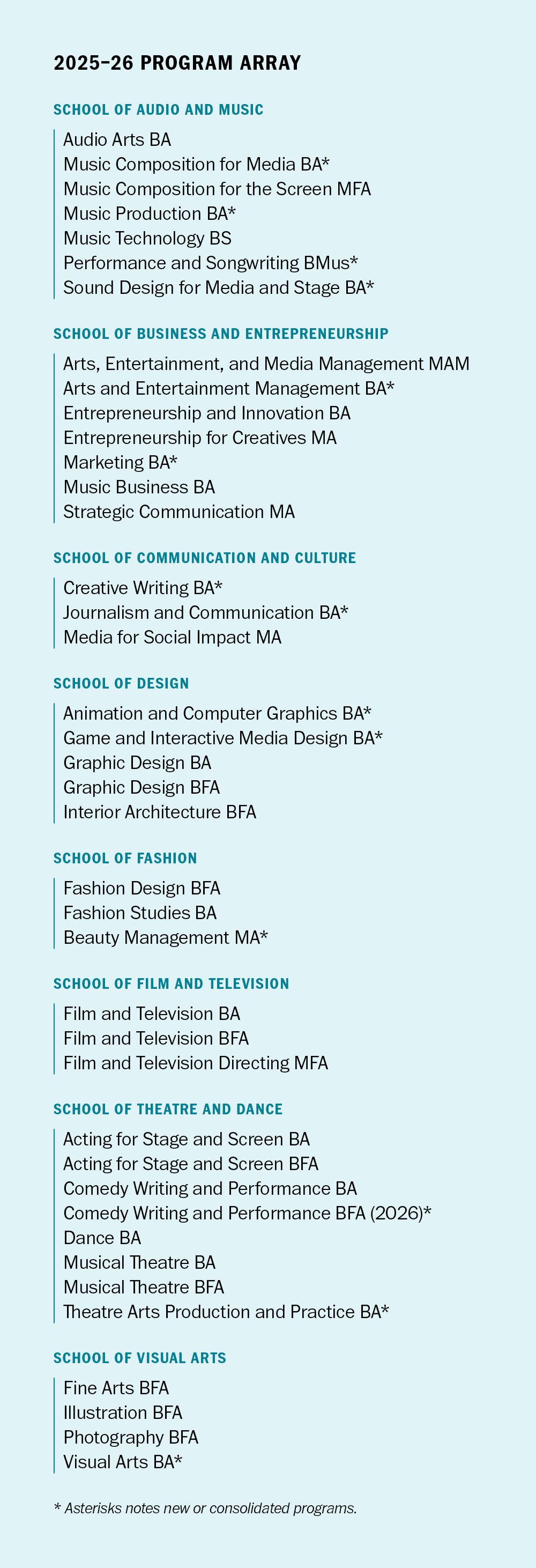Academic Program Array
Message from Interim President Jerry Tarrer (12/16/24)
Over the past few months, we have reaffirmed our deep commitment to our mission and our central tenet that “creative careers start here” in order to solidify Columbia’s standing as a preferred destination for talented young creatives from all backgrounds.
Today, we are rolling out a revitalized array of academic offerings designed to keep our college competitive in an increasingly challenging higher education landscape and position our students to be ever-more competitive in their professional endeavors.
This is a logical and necessary step in our 135-year history of continued reinvention to provide a creative education grounded in real-world demands and opportunities.
The provost, with input from the faculty, school directors and deans, led a process to reimagine our program array that will promote future growth centered around student success, and meet students’ interests around services and outcomes. I want to express my gratefulness to everyone who took part in and informed this process in addition to carrying out all their other duties at the college. I especially wish to thank the faculty for their creative and thoughtful approach to this project, which has resulted in an exciting and forward-looking new program array.
Earlier today, the provost and I shared our plan with our Board of Trustees. The finalized strategic realignment of the college’s program array will be in place for the 2025-26 academic year. It will empower us to invest in areas of potential growth that correspond to market demand.
This fall, Columbia will launch a new beauty management program marketed to beauty and wellness professionals with a focus on diversity and sustainability initiatives in the beauty industry. The college is also exploring the creation of new programs in film and television production, textile design, professional writing and industrial design, which are areas that are experiencing growth in employer demand and correspond to centers of excellence at Columbia.
Some programs will be phased out, others will be combined or integrated into other programs. Columbia will now offer 33 undergraduate degrees and 7 graduate degrees, representing a stronger and better array of programs aligned with where creative careers and industries are headed.
Programs designated to sunset or merge will give students an opportunity to finish their program at Columbia without interruption, although they also will have the option to explore segueing into an adjacent program or major at the college if they choose and their status allows. None of the changes announced today for next fall impact the spring ’25 schedule and the courses for which students have registered.
Nine programs will consolidate existing programs or new concentrations:
- The Marketing BA will regroup Marketing, Social Media and Digital Strategy, Public Relations, and Advertising.
- The new Animation and Computer Graphics BA will regroup Game Art, Animation, Computer Animation, and Traditional Animation.
- The new Game and Interactive Media Design BA will regroup Game Design and Immersive Media, Programming, and User Experience (UX).
- The new Journalism and Communication BA will regroup Communication, Journalism, Radio, and Photojournalism.
- The Creative Writing BA will regroup Creative Writing and English.
- The new Theatre Arts Production and Practice BA will regroup Theatre, and Theatre Design and Technology.
- The new Visual Arts BA will regroup Photography, Fine Arts, and Illustration.
- The Design Management BA will be merged with the Arts Management BA to be the Arts and Entertainment Management BA.
- The Dance BA and Dance BFA will merge into a Dance BA.
As reflected above, the following degrees will no longer be offered but will be integrated into new degrees (for instance, Columbia will go from having both a Dance BA and BFA to having a Dance BA; as another example, the Computer Animation BFA and Traditional Animation BFA will no longer be offered but Computer Animation and Traditional Animation will join Animation and Game Art as components of a new Animation and Computer Graphics BA):
- Computer Animation BFA
- Dance BFA
- Design Management BA
- English BA
- Immersive Media BA
- Programming BS
- Traditional Animation BFA
The following will no longer be offered as a degree or as part of a degree at Columbia, though some courses may continue to be offered:
- Environmental and Sustainability Studies BA
- American Sign Language BA
- Cultural Studies BA
- Art History BA
Disciplines no longer offered as discrete undergraduate majors will continue to be represented in specific course content, standalone courses, minors, and/or concentrations and curricular pathways.
The 7 graduate programs being discontinued are:
- Creative Writing MFA
- User Experience and Interaction Design MA
- Cinema and Television Producing MFA
- Acting and Contemporary Performance Making MA
- Acting and Contemporary Performance Making MFA
- Fine Arts MFA
- Photography MFA
Enrollment of new students in the discontinued programs will cease effective Fall ’25; the college is reaching out to applicants into those programs. No further program consolidations or eliminations are under consideration for the 2026-27 academic year.
Other programs not merging or being discontinued will also see changes designed to simplify student paths to graduation, expand collaborative opportunities, and revise the number of courses to allow robust required and elective course numbers while bringing our offerings more in line with levels at institutions comparable to Columbia in size and scope. These modifications will be described in detail in a report to be shared by the Provost tomorrow.
We expect there will be up to 25 full-time faculty position eliminations. With the array now defined, the provost's office will determine which full-time faculty departures will be necessary. Impacted faculty members will be notified in January, upon completion of that process. No staff separations will take place as a result of this program array realignment.
I acknowledge these decisions are painful. The loss of our colleagues has an impact on the Columbia community. However, these actions are also necessary for the long-term success of our cherished college.
The transformational achievements of our 135-year history speak to our ability to successfully navigate this moment and continue our mission of preparing creatives for successful careers for many generations to come.
I am confident that this revised set of program offerings will amplify the voices of our diverse student population and prepare the next generation of creatives to launch their careers at Columbia.
Sincerely,
Jerry Tarrer, Interim President




Frequently Asked Questions
Consolidated Programs FAQs
Discontinued Programs FAQs
Student and Family-Focused FAQs
Alumni-Focused FAQs
General FAQs
Contact Information
- Prospective students should contact the Admissions Department at admissions@colum.edu.
- Alumni should contact the Development and Alumni Relations Department at alumni@colum.edu.
- Current students should contact Advising at collegeadvising@colum.edu.
- Current students can also contact their school directors per the following:
- School of Design - designprograms@colum.edu
- School of Visual Arts - visualartsprograms@colum.edu
- School of Business and Entrepreneurship - beprograms@colum.edu
- School of Film and Television Reception - filmandtvprograms@colum.edu
- School of Communication and Culture - sccprograms@colum.edu
- School of Theatre & Dance - theatredanceprograms@colum.edu
- School of Audio and Music - samprograms@colum.edu
- School of Fashion - schooloffashion@colum.edu
- Media inquiries should contact Strategic Communications and External Relations at campuscomms@colum.edu